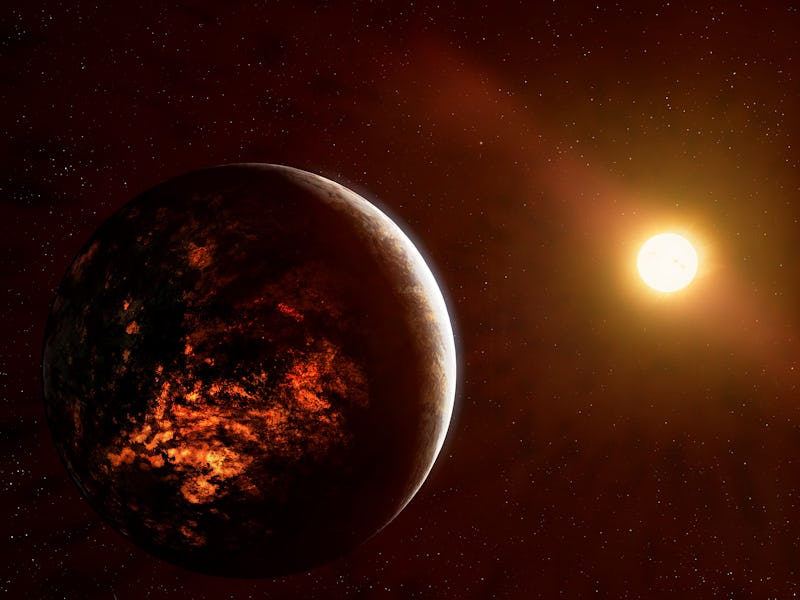The Webb Telescope Found A Lava Planet with a Carbon Dioxide Atmosphere
55 Cancri e is a terrible place, but at least its atmosphere isn't actually vaporized rock.

The lava world 55 Cancri e doesn’t have an atmosphere of vaporized rock after all, according to recent data from the James Webb Space Telescope (JWST).
A recent study suggests that 55 Cancri e — a planet about twice the size of Earth, which orbits a star 40 light years away — has a thick atmosphere made mostly of either carbon monoxide or carbon dioxide. The carbon-rich atmosphere is probably made of gas that escaped from the sea of molten rock that covers the planet’s surface. In that case, it’s not very surprising that 55 Cancri e should have an atmosphere made mostly of carbon and oxygen, since previous studies of the planet have suggested that the whole thing might be made mostly of carbon, with an interior of solid diamond thanks to the tremendous heat and pressure.
Exoplanet researcher Renyu Hu, of NASA’s Jet Propulsion Laboratory, and his colleagues published their work in the journal Nature.
This artist’s illustration shows what 55 Cancri e might look like.
The Floor is Lava – and the Sky is Poison
As 55 Cancri e passed behind its host star, its dayside — the half of the planet that constantly faces the searing heat of its star — briefly pointed toward Earth. Hu and his colleagues measured the spectrum of light coming from the planet’s dayside using two of JWST’s instruments: the Near-Infrared Camera (NIRCam) and the Mid-Infrared Instrument (MIRI). That information revealed not only the temperature on the planet’s star-scorched dayside, but the chemical makeup of the atmosphere that surrounds it.
NIRCam and MIRI revealed that there’s a thick layer of either carbon monoxide or carbon dioxide wrapped around 55 Cancri e, laced with other molecules made of carbon, hydrogen, nitrogen, oxygen, phosphorus, and sulfur – things like water vapor, sulfur dioxide (the chemical that gives volcanic gas its rotten egg smell), and molecular nitrogen. And that noxious atmosphere is probably made of gas that escaped from bubbles in the super-hot lava that makes up the planet’s surface.
According to Hu and his colleagues, the atmosphere is “a percent of [the planet’s] radius.” Since 55 Cancri e is about twice as wide as Earth (and 8.8 times more massive), the atmosphere could be anywhere from 80 to 800 miles thick. And beneath it lies an endless sea of molten rock.
There is no solid ground on 55 Cancri e, as far as astronomers know; the planet orbits less than a million miles away from its star, which is only slightly smaller than our Sun. Even daring Mercury, in our own Solar System, orbits about 41 million miles from the Sun. 55 Cancri e is so close to its star that its whole surface is molten; even its permanently darkened night side bakes at around 2,500 degrees Fahrenheit.
Astronomers have long known this exoplanet as a hellish world with a molten lava surface, but they weren’t sure what kind of atmosphere, if any, surrounded it. Other studies of the lava world had ruled out the idea that it still hung onto the atmosphere it was born with, which would have been a thick layer of hydrogen and helium. That ancient atmosphere is long gone, blown away by 55 Cancri’s powerful stellar winds. Some astronomers have suggested that because the planet is so hot, its atmosphere might be made of vaporized rock — but that doesn’t fit the latest JWST data.
“The measurements rule out the scenario where the planet is a lava world shrouded by a tenuous atmosphere made of vaporized rock,” write Hu and his colleagues in their recent paper. Instead, 55 Cancri e appears to be a lava world shrouded by a thick layer of gases belched out by the churning lava that covers its surface.